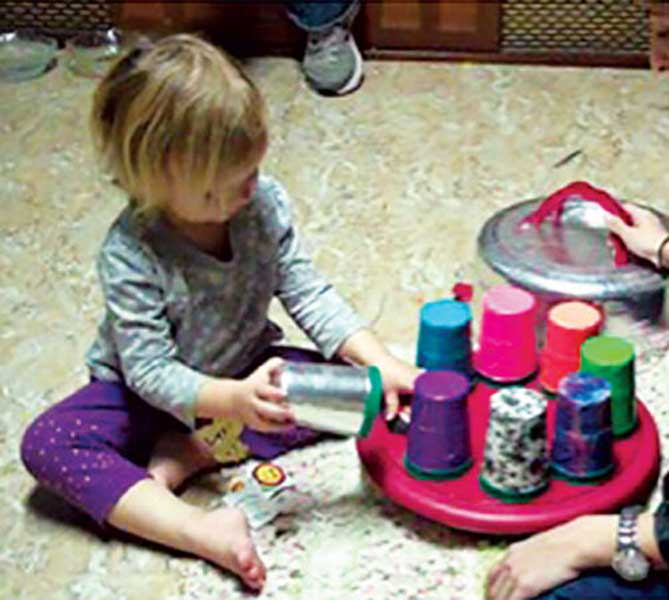Puberty may reboot the brain and behaviors and can reshape responses to stress in children who faced trauma early in life.

A preschooler slips stickers under some of the colored cups on a lazy Susan tray, then gives the tray a whirl. When the spinning stops, the child must find the hidden stickers. Most kids remember where they are. But a few have to check every single cup.
This game tests working memory — the brain’s system for storing and retrieving recent information. It’s among a set of mental skills known as executive function. These skills develop poorly in young kids who face trauma, such as physical abuse or neglect. From then on, throughout life, the body’s systems tend to respond differently, observes Megan Gunnar. She’s a child psychologist at the University of Minnesota in Minneapolis.
A childhood filled with hardship, negligence, or abuse can skew the system that regulates how the body responds to stress. Problems in this stress response set kids on a path toward behavior struggles. As they grow up, these kids also face an elevated risk for depression, diabetes, and a host of other health problems.
But that difficult future may not be set in stone. Stress responses can return to normal during puberty, Gunnar and others have shown. This raises the prospect that some impacts of early trauma can be erased.
What is puberty?
The new research is prompting a rethink of puberty. It’s not just a time of acne, armpit hair, and other uncomfortable body changes. Puberty also may be a window of opportunity. It could be when kids who got a difficult start get a chance to reset how their bodies respond to stress.
Surprised by stress
When the brain perceives a threat — an angry family member, a stressful exam, a high-stakes competition — levels of a hormone shoot up. Called adrenaline (Ah-DREN-uh-lin), this chemical sets off what is known as the “fight-or-flight” reaction. Breathing and heart rate soar. Palms get sweaty. Sight and other senses sharpen. Soon the brain releases chemical messengers. They go to the kidneys. This stimulates the nearby adrenal glands to release another hormone. It’s called cortisol.
What is a hormone?
Cortisol moves sugars into the blood for quick energy. It slows digestion and immune responses. It also slows the growth and other processes considered nonessential in a fight-or-flight situation.
When the threat passes, adrenaline and cortisol levels fall. The heart’s rate slows. Other systems resume business as usual. The stress response turns off.
By the time Gunnar started work on her Ph.D. in the 1970s, researchers had mapped out the key actors in this process. These signals from the HPA axis. Those letters stand for the three hormone systems that work together here: hypothalamic (Hy-poh-thah-LAM-ik), pituitary (Pih-TOO-ih-tair-ee), and adrenal (Ah-DREE-nul). Gunnar set out to study how the HPA axis influences the brain and behavior in people.
A bit of stress may help young people build resilience
Studies in rodents and monkeys had shown that adversity early in life throws the HPA axis off-kilter. These types of studies weren’t easy. To measure cortisol, scientists had to collect blood or urine. Then methods were developed for measuring cortisol from samples of saliva. That was a lot simpler to get.
In the mid-1980s, Gunnar studied this neuroendocrine system in newborns. She showed that having a secure parent relationship regulates the system. It helps babies deal with stressful situations, such as getting vaccines. “You can go to the doctor as a baby and get a big shot in one leg and the other leg and you’re crying your head off … but [the HPA axis] doesn’t kick-off,” notes Gunnar. But if babies get separated from their parents for even a few minutes, “their H`A axis shoots up like a rocket.”
Setting off this system once in a while isn’t harmful. It’s what helps us learn to cope with stress. But what if that sense of safety is disrupted for far longer?
To find out, Gunnar and a research team ventured to eastern Romania in Europe during the mid-1990s. For decades, thousands of Romanian children had grown up in orphanages. Conditions there often were crowded and grim. “You walk into these wards and all of a sudden you’re mobbed by kids saying ‘mama, mama, mama’ — and reaching their arms up to get held,” recalls Gunnar. She had two school-aged sons at the time. “It was awful. I just wanted to bring them all home.”
What she did bring back to Minnesota, along with that searing memory, was a set of small vials. Each held a sample of saliva from one of the 2- and 3-year-old orphans. Cortisol is the end product of the neuroendocrine cascade. So measuring the children’s cortisol offered a window into the stress effects of their parental deprivation.
Analyses like these are tricky. Whether a kid faces poverty or neglect, “the way you start out in life tends to continue,” Gunnar says. A report published last November by the Centers for Disease Control and Prevention points to those long-term consequences. People who experienced childhood trauma are more likely to smoke or drink heavily, it found. These people are more likely to drop out of high school. They also develop heart disease and a host of other chronic conditions at higher rates.
This doesn’t mean that having a completely smooth life is good. Growing research suggests that some adversity — such as dealing with a bad grade or a challenging friendship — can help a child build resilience. And there may be a sweet spot for how much hardship brings this benefit without becoming overwhelming.







